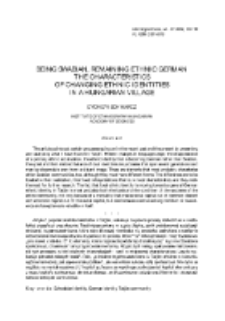
Object
Title: Being Swabian, remaining ethnic German. The characteristics of changing ethnic identities in a Hungarian village
Subtitle:
Publisher:
Institute of Archaeology and Ethnology Polish Academy of Sciences
Place of publishing:
Description:
Type of object:
Abstract:
The article points out certain processes going on in the recent past and the present by presenting and analyzing what I have found in Tarján. Present changes in language usage, the disappearance of a primary ethnic socialization, the ethnic identity that is becoming German rather than Swabian, the upset and then restored balance of dual identities are processes that span several generations and may be discernable even from a distant image. These are elements that most probably characterize other Swabian communities, too, although they must have different forms. The differences are to be located in their realization, their local interpretations: that is, in local characteristics; and they mark the need for further research. The fact that local ethnic identity is moving towards a general German ethnic identity in Tarján is most probably both the basis and the condition of the successes of the entire community, not only because of a mentality that creates social capital out of common descent and economic capital out of this social capital, but also because a centuries long tradition of coexistence and acceptance is valuable in itself
References:
Andrásfalvy Bertalan 1973, Ellentétes értékrendek összeütközese es a polgárosodás (A Clash of Values and Bourgeoisification), Tiszatáj 27. 8, pp. 105—110
Barth Fredrik 1969, Ethnic groups and boundaries. The social organization of culture difference, Bergen — Oslo — London
Bausinger Hermann 1995, Népi kultúra a technika korszakában (Folk Culture in the Age of Technology), Osiris-Századvég, Budapest
Bindorffer Györgyi 2001, Kettös identitás. Etnikai és nemzeti azonosságtudat Dunabogdányban (Dual identities. Ethnic and National Identity in Dunabogdány), Új Mandátum Knyvkiadó — MTA Kisebbsegkutató Intezet, Budapest
Bindorffer Györgyi 2002 Törtenelmi tudat, nemzeti identitás. Svábok Baranyában es Pest megyeben. (Historical consciousness, national identity. Swabians in Baranya and Pest county), [in:] ed. Felkai Gábor, Molnár Attila Károly, Pál Eszter, Forrásvidékek. Társadalomtudományi tanulmányok Némedi Dénes 60. szuletésnapjára (Sources. Studies in Sociology for Dénes Némedís 60th birthday), Új Mandátum Knyvkiadó, Budapest, pp. 339—352
Demeter Zayzon Mária 2002, A nemzetiségi anyanyelvi állapotok alakulása 1989—1997 között németek/szlovákok lakta települeseken (The changes in language usage between 1989 and 1997 in German/Slovak villages), [in:] Mária Demeter Zayzon, Kisebbségek-k0z0sségek határon innen és túl. Válogatott írások a kisebbségkutatás könböl (Minorities and communities inside and outside Hungary. Selected studies in minority research), BIP, Budapest, pp. 81—92
Juhász Erika 1996, Újraválasztott polgármesterek es változó összetetelü közgyülesek (Reelected mayors and changing assemblies), [in:] ed. Böhm Antal, Szoboszlai György, Onkormányzati választások 1994. Politikai szociológiai k0rkép (Local elections 1994. A political sociological overview), MTA Politikai Tudományok Intezete, Budapest, pp. 339—364
Kovács Eva 2004, Vakmerö tezisek az identitásról (Daring Theses on Identity), [in:] ed. Fedinec Csilla, Nemzet a társadalomban (Nation in the Society), Teleki László Alapítvány, Budapest, pp. 221—234
Kósa László 1998, Paraszti polgárosulás és a népi kultúra táji megoszlása Magyarországon (1880—1920) (The bourgeoisification of peasants and different ethnic cultures in Hungary, 1880—1920), Planetás, Budapest
Mikonya József 1992, Tarjáni krónika. Tarján k0zség a t0rténelem túkrében (A Chronicle of Tarján. The village in history), Tarjáni Polgármesteri Hivatal — Tarján Közsegert Baráti Kör
Schwarcz Gyöngyi 2004, Leosztott szerepek, kitöresi kíserletek (Pre-arranged roles, attempts of re-arrangement: women in local councils and local decision-making procedure), [in:] ed. Sáfrány Reka, Eletpályák és mozgásterek: nök a helyi k0zéletben (Walks of life and latitudes: women in local public life), Magyarországi Nöi Alapítvány (Hungarian Woman Found) MONA, pp. 49—65
Treszl Anton 1998, Ein ungarndeutsches Dorf und seine Umgebung Tarian — Tarján. Egy magyarországi német falu és k0rnyéke II., Fülöp István, Tarján
Relation:
Volume:
Start page:
End page:
Detailed Resource Type:
Format:
Resource Identifier:
oai:rcin.org.pl:61493 ; 0137-4079
Source:
IAiE PAN, call no. P 366 ; IAiE PAN, call no. P 367 ; IAiE PAN, call no. P 368 ; click here to follow the link
Language:
Rights:
Rights Reserved - Restricted Access
Terms of use:
Digitizing institution:
Institute of Archaeology and Ethnology of the Polish Academy of Sciences
Original in:
Library of the Institute of Archaeology and Ethnology of the Polish Academy of Sciences
Access:
Object collections:
- Institute of Archeology and Ethnology PAS > Institute Publications
- Institute of Archeology and Ethnology PAS > Institute Publications > Current Journals
- Institute of Archeology and Ethnology PAS > Institute Publications > Current Journals > Ethnologia Polona
Last modified:
Feb 2, 2022
In our library since:
Jan 12, 2017
Number of object content downloads / hits:
18
All available object's versions:
https://www.rcin.org.pl/iae/publication/77289
Show description in RDF format:
Show description in RDFa format:
Show description in OAI-PMH format:
Objects Similar
Szczepaniak-Kroll, Agnieszka

 INSTYTUT ARCHEOLOGII I ETNOLOGII POLSKIEJ AKADEMII NAUK
INSTYTUT ARCHEOLOGII I ETNOLOGII POLSKIEJ AKADEMII NAUK
 INSTYTUT BADAŃ LITERACKICH POLSKIEJ AKADEMII NAUK
INSTYTUT BADAŃ LITERACKICH POLSKIEJ AKADEMII NAUK
 INSTYTUT BADAWCZY LEŚNICTWA
INSTYTUT BADAWCZY LEŚNICTWA
 INSTYTUT BIOLOGII DOŚWIADCZALNEJ IM. MARCELEGO NENCKIEGO POLSKIEJ AKADEMII NAUK
INSTYTUT BIOLOGII DOŚWIADCZALNEJ IM. MARCELEGO NENCKIEGO POLSKIEJ AKADEMII NAUK
 INSTYTUT BIOLOGII SSAKÓW POLSKIEJ AKADEMII NAUK
INSTYTUT BIOLOGII SSAKÓW POLSKIEJ AKADEMII NAUK
 INSTYTUT CHEMII FIZYCZNEJ PAN
INSTYTUT CHEMII FIZYCZNEJ PAN
 INSTYTUT CHEMII ORGANICZNEJ PAN
INSTYTUT CHEMII ORGANICZNEJ PAN
 INSTYTUT FILOZOFII I SOCJOLOGII PAN
INSTYTUT FILOZOFII I SOCJOLOGII PAN
 INSTYTUT GEOGRAFII I PRZESTRZENNEGO ZAGOSPODAROWANIA PAN
INSTYTUT GEOGRAFII I PRZESTRZENNEGO ZAGOSPODAROWANIA PAN
 INSTYTUT HISTORII im. TADEUSZA MANTEUFFLA POLSKIEJ AKADEMII NAUK
INSTYTUT HISTORII im. TADEUSZA MANTEUFFLA POLSKIEJ AKADEMII NAUK
 INSTYTUT JĘZYKA POLSKIEGO POLSKIEJ AKADEMII NAUK
INSTYTUT JĘZYKA POLSKIEGO POLSKIEJ AKADEMII NAUK
 INSTYTUT MATEMATYCZNY PAN
INSTYTUT MATEMATYCZNY PAN
 INSTYTUT MEDYCYNY DOŚWIADCZALNEJ I KLINICZNEJ IM.MIROSŁAWA MOSSAKOWSKIEGO POLSKIEJ AKADEMII NAUK
INSTYTUT MEDYCYNY DOŚWIADCZALNEJ I KLINICZNEJ IM.MIROSŁAWA MOSSAKOWSKIEGO POLSKIEJ AKADEMII NAUK
 INSTYTUT PODSTAWOWYCH PROBLEMÓW TECHNIKI PAN
INSTYTUT PODSTAWOWYCH PROBLEMÓW TECHNIKI PAN
 INSTYTUT SLAWISTYKI PAN
INSTYTUT SLAWISTYKI PAN
 SIEĆ BADAWCZA ŁUKASIEWICZ - INSTYTUT TECHNOLOGII MATERIAŁÓW ELEKTRONICZNYCH
SIEĆ BADAWCZA ŁUKASIEWICZ - INSTYTUT TECHNOLOGII MATERIAŁÓW ELEKTRONICZNYCH
 MUZEUM I INSTYTUT ZOOLOGII POLSKIEJ AKADEMII NAUK
MUZEUM I INSTYTUT ZOOLOGII POLSKIEJ AKADEMII NAUK
 INSTYTUT BADAŃ SYSTEMOWYCH PAN
INSTYTUT BADAŃ SYSTEMOWYCH PAN
 INSTYTUT BOTANIKI IM. WŁADYSŁAWA SZAFERA POLSKIEJ AKADEMII NAUK
INSTYTUT BOTANIKI IM. WŁADYSŁAWA SZAFERA POLSKIEJ AKADEMII NAUK
































